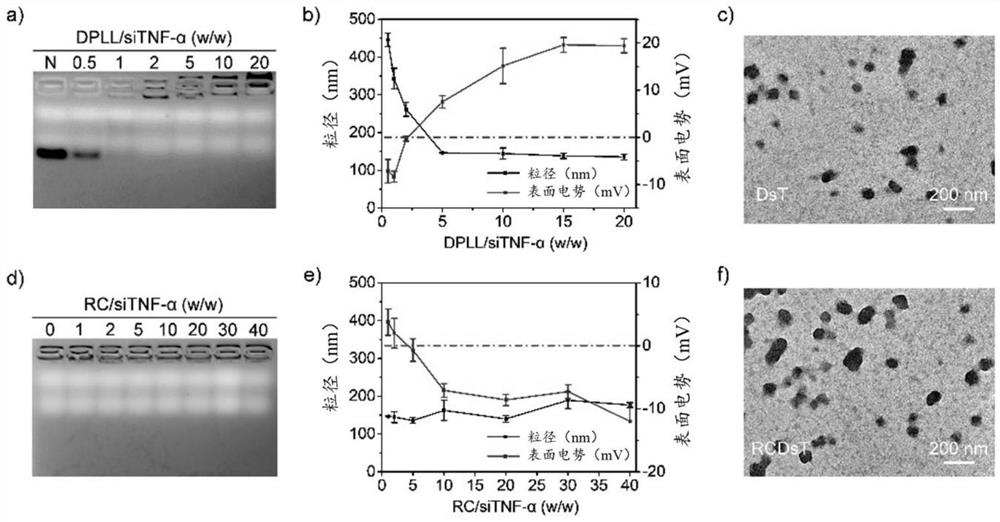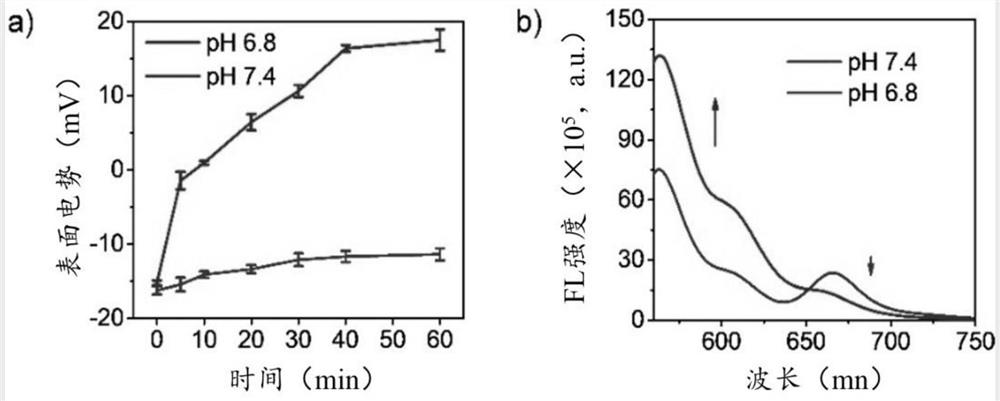Lung gene delivery system and preparation method and application thereof
A gene delivery and lung technology, applied in gene therapy, pharmaceutical formula, drug delivery, etc., can solve the problems of weakened anti-inflammatory effect, inability to achieve mucus layer penetration, inability to achieve gene transfection, etc., and achieve high-efficiency gene transfection Effect
- Summary
- Abstract
- Description
- Claims
- Application Information
AI Technical Summary
Problems solved by technology
Method used
Image
Examples
Embodiment 1
[0052] Dissolve siTNF-α and DPLL in DEPC water (pH 7.4) at concentrations of 0.1 mg / mL and 0.5 mg / mL, respectively. Then the DPLL solution was added to the siTNF-α solution at different ratios (DPLL / siTNF-α = 0.5 / 1, 1 / 1, 2 / 1, 5 / 1, 10 / 1 and 20 / 1, w / w), Vortex for 5 s and incubate at 37 °C for 30 min to obtain DsT solution. For RCDsT ternary nanocomposites, RC was dissolved in DEPC water (pH 7.4) at a concentration of 10 mg / mL at different ratios (RC / siTNF-α = 1 / 1, 2 / 1, 5 / 1, 10 / 1, 20 / 1, 30 / 1 and 40 / 1, w / w) were added to the prepared DsT solution (DPLL / siTNF-α = 5 / 1, w / w), vortexed for 5 s, 37 °C The RCDsT ternary nanocomposite was obtained by incubating for 30 min.
Embodiment 2
[0059] RAW 264.7 cells were seeded into 96-well plates at a density of 2 × 10 4 / Wells were incubated with DMEM containing 10% FBS at 37°C, 5% CO 2 Incubate under the condition for 24 h. Add FAM-siRNA-containing RGDsT (w / w / w = 40 / 5 / 1) nanocomplexes and RCDsT (w / w / w = 40 / 5 / 1) nanocomposite. Continue to incubate at 37°C for 4 h, rinse with PBS containing sodium heparin (20 U / mL) three times, and lyse with RIPA lysate (100 µL / well). respectively with a microplate reader ( lambda ex / lambda em = 492 / 518 nm) and BCA kit to determine FAM-siRNA and protein content. Cell uptake efficiency is expressed in μg FAM-siRNA / mg protein.
[0060] RAW 264.7 cells were seeded into 6-well plates at a density of 4 × 10 5 / well, and cultured in DMEM containing 10% FBS at 37°C, 5% CO 2 Incubate under the condition for 24 h. Add FAM-siRNA-containing RGDsT (w / w / w = 40 / 5 / 1) nanocomplexes and RCDsT (w / w / w = 40 / 5 / 1) nanocomposite. Continue to incubate at 37 °C for 4 h, rinse with PBS c...
Embodiment 3
[0067]DsT (w / w = 5 / 1, 2 μg Cy3-siRNA, 20 μL) nanocomplex containing Cy3-siRNA and RCDsT (w / w / w = 40 / 5 / 1, 2 μg Cy3-siRNA, 20 μL) nanocomposites were fully mixed with cystic fibrosis patient sputum (3%, w / w, 200 μL), and incubated at 37 °C for 30 min. Then the sample was transferred to a small dish dedicated to CLSM, observed under a microscope, and the Brownian motion of each group of nanoparticles was recorded. The recording time was 20 s, and the data analysis software was Imaris. The Brownian motion of DsT nanocomposites and RCDsT nanocomplexes in sputum was observed by multi-particle tracking technique (MPT). Such as Figure 9 As shown in a, the Brownian motion of the DsT nanocomposite was severely hindered in sputum, while the Brownian motion of the RCDsT nanocomposite was more severe. mean square displacement ( ) shows quantitatively that when the particle motion time is 10 s, the RCDsT particles About 1000 times that of DsT particles ( Figure 9 b). Furthermore, ...
PUM
| Property | Measurement | Unit |
|---|---|---|
| pore size | aaaaa | aaaaa |
| particle diameter | aaaaa | aaaaa |
Abstract
Description
Claims
Application Information
 Login to View More
Login to View More - R&D
- Intellectual Property
- Life Sciences
- Materials
- Tech Scout
- Unparalleled Data Quality
- Higher Quality Content
- 60% Fewer Hallucinations
Browse by: Latest US Patents, China's latest patents, Technical Efficacy Thesaurus, Application Domain, Technology Topic, Popular Technical Reports.
© 2025 PatSnap. All rights reserved.Legal|Privacy policy|Modern Slavery Act Transparency Statement|Sitemap|About US| Contact US: help@patsnap.com



